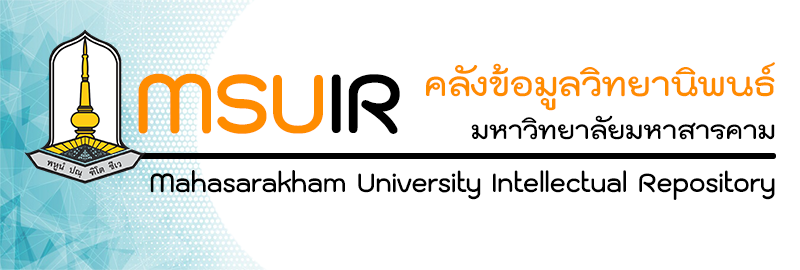Please use this identifier to cite or link to this item:
http://202.28.34.124/dspace/handle123456789/2851| Title: | Developing Problem-Solving Ability in Chemistry of Mathayomsuksa 4 Student By using Deductive Learning with the DAPIC approach การพัฒนาความสามารถการแก้โจทย์ปัญหาในรายวิชาเคมีของนักเรียนชั้นมัธยมศึกษาปีที่ 4 โดยการจัดการเรียนรู้แบบนิรนัยร่วมกับกระบวนการแก้ปัญหา DAPIC |
| Authors: | Haruethai Duangsopa หฤทัย ดวงโสภา Prasart Nuangchalerm ประสาท เนืองเฉลิม Mahasarakham University Prasart Nuangchalerm ประสาท เนืองเฉลิม prasart.n@msu.ac.th prasart.n@msu.ac.th |
| Keywords: | ความสามารถการแก้โจทย์ปัญหาในรายวิชาเคมี,กระบวนการแก้ปัญหา DAPIC,การจัดการเรียนรู้แบบนิรนัย Problem-Solving Ability in Chemistry DAPIC approach Deductive Learning |
| Issue Date: | 13 |
| Publisher: | Mahasarakham University |
| Abstract: | The action research in the classroom this time aims to enhance problem- solving skills in chemistry for 4th-year high school students by using Deductive Learning with the DAPIC approach, with a passing criterion of 70% or higher of the full score. The target group consists of 4th-year students (Class 4/4) from the demonstration school of Mahasarakham University (secondary level) in the second semester of the academic year 2023, totaling 22 students. The data collection tools include: 9 lesson plans utilizing collaborative and problem-solving learning management with the DAPIC approach for the chemistry topic of quantitative relationships. Three sets of essay-type problem-solving tests in chemistry, each comprising 3 questions. Student interview questionnaires regarding their opinions on the learning management. Observational data on problem-solving behavior in chemistry. Statistical analysis methods employed for data analysis include percentages, mean values, and standard deviations.
The research findings indicate that target group students' problem-solving abilities in chemistry improved after receiving student-centered learning combined with the DAPIC problem-solving process. In practical cycle 1, 11 out of 22 students passed the 70% criterion, representing 50%, with a problem-solving test score of 15.59. In practical cycle 2, 18 out of 22 students passed the 70% criterion, representing 81.82%, with a problem-solving test score of 18.41. In practical cycle 3, 21 out of 22 students passed the 70% criterion, representing 95.45%, with a problem-solving test score of 19.59. Quality reflections reveal that in practical cycle 1, most students still lacked understanding of the learning process, resulting in confusion when solving chemistry problems. Students couldn't fully articulate the problem requirements, plan, or design problem-solving methods, and thus couldn't demonstrate problem-solving methods, including summarizing and checking answers. As students gained understanding of the learning process and problem-solving components, along with practicing problem-solving exercises in practical cycles 2 and 3, it led to an increase in chemistry problem-solving test scores with student-centered learning combined with the DAPIC problem-solving process. การวิจัยเชิงปฏิบัติการในชั้นเรียนครั้งนี้มีความมุ่งหมายเพื่อพัฒนาความสามารถการแก้โจทย์ปัญหาในรายวิชาเคมีของนักเรียนชั้นมัธยมศึกษาปีที่ 4 โดยการจัดการเรียนรู้แบบนิรนัยร่วมกับกระบวนการแก้ปัญหา DAPIC ให้ผ่านเกณฑ์ร้อยละ 70 ของคะแนนเต็ม กลุ่มเป้าหมาย ได้แก่ นักเรียนชั้นมัธยมศึกษาปีที่ 4/4 ของโรงเรียนสาธิตมหาวิทยาลัยมหาสารคาม (ฝ่ายมัธยม) ภาคเรียนที่ 2 ปีการศึกษา 2566 จำนวน 22 คน โดยเครื่องมือที่ใช้ในการเก็บรวบรวมข้อมูลได้แก่ 1) แผนการจัดการเรียนรู้ที่ใช้การจัดการเรียนรู้แบบนิรนัยร่วมกับกระบวนการแก้ปัญหา DAPIC เนื้อหาวิชาเคมี เรื่อง ปริมาณสารสัมพันธ์ 2 จำนวน 9 แผน 2) แบบทดสอบความสามารถการแก้โจทย์ปัญหาในรายวิชาเคมีที่มีลักษณะเป็นแบบอัตนัย ชุดละ 3 ข้อ มีจำนวน 3 ชุด 3) แบบสัมภาษณ์ความคิดเห็นของนักเรียนที่มีต่อการจัดการเรียนรู้ 4) แบบสังเกตพฤติกรรมการแก้โจทย์ปัญหาในรายวิชาเคมี สถิติที่ใช้ในการวิเคราะห์ข้อมูล ได้แก่ ร้อยละ ค่าเฉลี่ย และส่วนเบี่ยงเบนมาตรฐาน ผลการวิจัยพบว่า นักเรียนกลุ่มเป้าหมายมีคะแนนความสามารถการแก้โจทย์ปัญหาในรายวิชาเคมีหลังจากได้รับการจัดการเรียนรู้แบบนิรนัยร่วมกับกระบวนการแก้ปัญหา DAPIC เพิ่มขึ้น โดยวงจรปฏิบัติการที่ 1 มีนักเรียนผ่านเกณฑ์ร้อยละ 70 จำนวน 11 คน คิดเป็นร้อยละ 50 และมีคะแนนแบบทดสอบในการแก้โจทย์ปัญหาเท่ากับ 15.59 วงจรปฏิบัติการที่ 2 มีนักเรียนผ่านเกณฑ์ร้อยละ 70 จำนวน 18 คน คิดเป็นร้อยละ 81.82 และมีคะแนนแบบทดสอบในการแก้โจทย์ปัญหาเท่ากับ 18.41 และวงจรปฏิบัติการที่ 3 มีนักเรียนผ่านเกณฑ์ร้อยละ 70 จำนวน 21 คน คิดเป็นร้อยละ 95.45 และมีคะแนนแบบทดสอบในการแก้โจทย์ปัญหาเท่ากับ 19.59 ผลสะท้อนเชิงคุณภาพ พบว่า ในวงจรปฏิบัติการที่ 1 นักเรียนส่วนใหญ่ยังขาดความเข้าใจด้านการจัดการเรียนรู้จึงส่งผลให้นักเรียนเกิดความสับสนในการแก้โจทย์ปัญหาในรายวิชาเคมี ซึ่งนักเรียนไม่สามารถบอกสิ่งที่เกี่ยวกับโจทย์ปัญหาได้ครบถ้วน นักเรียนไม่สามารถระบุวางแผนหรือออกแบบวิธีการแก้โจทย์ปัญหา โดยจะส่งผลให้นักเรียนไม่สามารถแสดงวิธีการแก้โจทย์ปัญหารวมไปถึงการสรุปและตรวจสอบคำตอบ และเมื่อนักเรียนมีความเข้าใจในกระบวนการจัดการเรียนรู้และองค์ประกอบของการแก้โจทย์ปัญหาเพิ่มขึ้น รวมไปถึงมีการให้นักเรียนฝึกฝนทำแบบฝึกหัดการแก้โจทย์ปัญหาในวงจรปฏิบัติการที่ 2 และวงจรปฏิบัติการที่ 3 จึงส่งผลให้คะแนนแบบทดสอบความสามารถการแก้โจทย์ปัญหาในรายวิชาเคมีด้วยการจัดการเรียนรู้แบบนิรนัยร่วมกับกระบวนการแก้ปัญหา DAPIC ของนักเรียนเพิ่มสูงขึ้น |
| URI: | http://202.28.34.124/dspace/handle123456789/2851 |
| Appears in Collections: | The Faculty of Education |
Files in This Item:
| File | Description | Size | Format | |
|---|---|---|---|---|
| 65010554013.pdf | 4.87 MB | Adobe PDF | View/Open |
Items in DSpace are protected by copyright, with all rights reserved, unless otherwise indicated.

